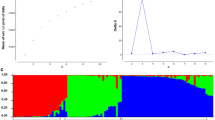Abstract
Cicer reticulatum, C. echinospermum, C. bijugum, C. judaicum, C. pinnatifidum, C. cuneatum and C. yamashitae are wild annual Cicer species and potential donors of valuable traits to improve chickpea (C. arietinum). As part of a large project to characterize and evaluate wild annual Cicer collections held in the world gene banks, AFLP markers were used to study genetic variation in these species. The main aim of this study was to characterize geographical patterns of genetic variation in wild annual Cicer germplasm. Phylogenetic analysis of 146 wild annual Cicer accessions (including two accessions in the perennial C. anatolicum and six cultivars of chickpea) revealed four distinct groups corresponding well to primary, secondary and tertiary gene pools of chickpea. Some possible misidentified or mislabelled accessions were identified, and ILWC 242 is proposed as a hybrid between C. reticulatum and C. echinospermum. The extent of genetic diversity varied considerably and was unbalanced between species with greatest genetic diversity found in C. judaicum. For the first time geographic patterns of genetic variation in C. reticulatum, C. echinospermum, C. bijugum, C. judaicum and C. pinnatifidum were established using AFLP markers. Based on the current collections the maximum genetic diversity of C. reticulatum, C. echinospermum, C. bijugum and C. pinnatifidum was found in southeastern Turkey, while Palestine was the centre of maximum genetic variation for C. judaicum. This information provides a solid basis for the design of future collections and in situ conservation programs for wild annual Cicer.




Similar content being viewed by others
References
Abbo S, Berger J, Turner NC (2003) Evolution of cultivated chickpea: four bottlenecks limit diversity and constrain adaptation. Funct Plant Biol 30:1081–1087
Benham JJ (2001) Genographer version 1.6, Boston. Available via http://hordeum.oscs.montana.edu/genographer
Berger J, Abbo S, Turner NC (2003) Ecogeography of annual Cicer species: the poor state of the world collection. Crop Sci 43:1076–1090
Capo-chichi LJA, Weaver DB, Morton CM (2001) AFLP assessment of genetic variability among velvetbean (Mucuna sp.) accessions. Theor Appl Genet 103:1180–1188
Choumane W, Winter P, Weigand F, Kahl G (2000) Conservation and variability of sequence-tagged microsatellite sites (STMSs) from chickpea (Cicer arietinum L.) within the genus Cicer. Theor Appl Genet 101:269–278
Croser JS, Ahmad F, Clarke HJ, Siddique KHM (2003) Utilisation of wild Cicer in chickpea improvement—progress, constraints, and prospects. Aust J Agr Res 54:429–444
Heslop-Harrison JS (2002) Exploiting novel germplasm. Aust J Agr Res 53:873–879
Iruela M, Rubio J, Cubero JI, Gil J, Millan T (2002) Phylogenetic analysis in the genus Cicer and cultivated chickpea using RAPD and ISSR markers. Theor Appl Genet 104:643–651
Kazan K, Muehlbauer FJ (1991) Allozyme variation and phylogeny in annual species of Cicer (Leguminosae). Plant Syst Evol 175:11–22
Muehlbauer FJ, Kaiser WJ, Simon CJ (1994) Potential for wild species in cool season food legume breeding. Euphytica 73:109–114
Nei M (1987) Molecular evolutionary genetics. Columbia University Press, New York
Nei M, Li WH (1979) Mathematical model for studying genetic variation in terms of restriction endonucleases. Proc Natl Acad Sci USA 76:5269–5273
Nguyen TT, Taylor PWJ, Redden RJ, Ford R (2004) Genetic diversity estimates in Cicer using AFLP analysis. Plant Breed 123:173–179
Sawkins MC, Maass BL, Pengelly BC, Newbury HJ, Ford-Lloyd BV, Maxted N, Smith R (2001) Geographical patterns of genetic variation in two species of Stylosanthes Sw. using amplified fragment length polymorphism. Mol Ecol 10:1947–1958
Serret MD, Udupa SM, Weigand F (1997) Assessment of genetic diversity of cultivated chickpea using microsatellite-derived RFLP markers: implications for origin. Plant Breed 116:573–578
Shan F, Clarke HJ, Yan G, Plummer JA, Siddique KHM (2004) Development of DNA fingerprinting keys for discrimination of Cicer echinospermum (P.H. Davis) accessions using AFLP markers. Aust J Agr Res 55:947–953
Shi GR (1993) Multivariate data analysis in palaeoecology and palaeobiogeography—a review. Palaeogeogr Palaeocl 105:199–234
Singh KB, Ocampo B (1993) Interspecific hybridization in annual Cicer species. J Genet Breed 47:199–204
Singh KB, Ocampo B (1997) Exploitation of wild Cicer species for yield improvement in chickpea. Theor Appl Genet 95:418–423
Singh KB, Malhotra RS, Halila MH, Knights EJ, Verma MM (1994) Current status and future strategy in breeding chickpea for resistance to biotic and abiotic stresses. Euphytica 73:137–149
Singh KB, Ocampo B, Robertson LD (1998) Diversity for abiotic and biotic stress resistance in the wild annual Cicer species. Genet Resour Crop Evol 45:9–17
Stamigna C, Crino P, Saccardo F (2000) Wild relatives of chickpea: multiple disease resistance and problems to introgression in the cultigen. J Genet Breed 54:213–219
Sudupak MA (2004) Inter and intra-species inter simple sequence repeat (ISSR) variation in the genus Cicer. Euphytica 135:229–238
Sudupak MA, Akkaya MS, Kence A (2004) Genetic relationships among perennial and annual Cicer species growing in Turkey assessed by AFLP fingerprinting. Theor Appl Genet 108:937–944
Swofford DL (2002) PAUP: phylogenetic analysis using parsimony (and other methods), version 4.0b10, Sinaur, Sunderland
van der Maesen LJG (1987) Origin, history and taxonomy of chickpea. In: Saxena MC, Singh KB (eds) The chickpea. CABI, UK, pp 11–34
Virk PS, Newbury HJ, Jackson MT, Ford-Lloyd BV (1995) The identification of duplicate accessions within a rice germplasm collection using RAPD analysis. Theor Appl Genet 90:1049–1055
Zeid M, Schon C-C, Link W (2003) Genetic diversity in recent elite faba bean lines using AFLP markers. Theor Appl Genet 107:1304–1314
Acknowledgements
Fucheng Shan is grateful to the Grains Research and Development Corporation of Australia (GRDC) for a Postdoctoral Fellowship. We thank Mr. Ted Knights, Dr. Jens Berger, Dr. James Ridsdill-Smith, Dr. Tanveer Khan, Tamworth Centre for Crop Improvement Australia, ICARDA, ICRISAT and USDA for providing germplasm. Molecular analysis for this study was conducted using facilities at the State Agricultural Biotechnology Centre, Murdoch University, Western Australia.
Author information
Authors and Affiliations
Corresponding author
Additional information
Communicated by P. Langridge
Rights and permissions
About this article
Cite this article
Shan, F., Clarke, H., Plummer, J. et al. Geographical patterns of genetic variation in the world collections of wild annual Cicer characterized by amplified fragment length polymorphisms. Theor Appl Genet 110, 381–391 (2005). https://doi.org/10.1007/s00122-004-1849-8
Received:
Accepted:
Published:
Issue Date:
DOI: https://doi.org/10.1007/s00122-004-1849-8




